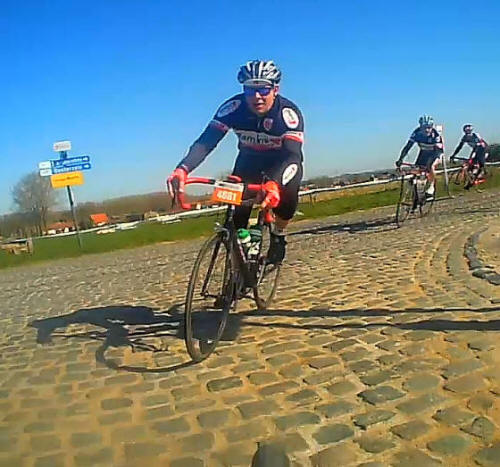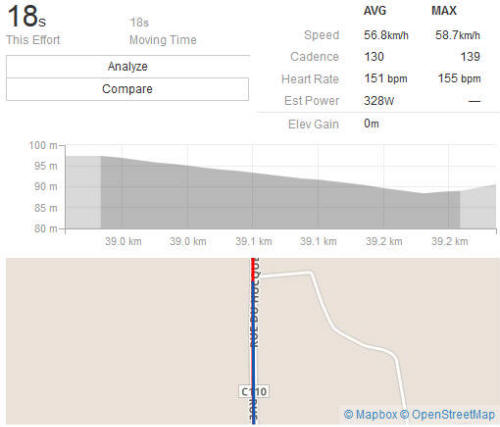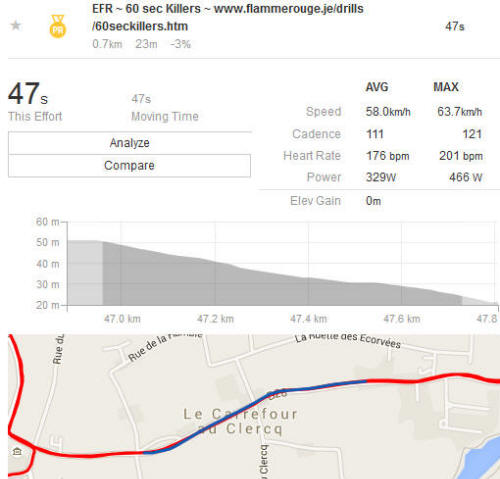Building Speed

The flamme
rouge 2015 train in full Flandrian flight
over the Mariaborstraat
EFR Road Captains ~
Chris O'Prey, Jason Stratford, Mick Heald
It matters not what discipline you undertake on your velocipede, every single one of us probably wishes we could ride our bike just a little bit faster than we now do.
In a previous factsheet we discussed the differences between strength and power, and showed you how to develop leg strength. The solution, although counter-intuitive, was relatively simple to implement, if not so simple to undertake.
Well it's exactly the same with speed; getting it is different, but easier than you might imagine. Here's how you can get yourself faster with a couple of (relatively) easy sessions per week.
Laying The Ground Work
Obviously, it's all in the preparation. There's no use trying
to build speed on an aerobic base that's as deep as a puddle.
So first, get your aerobicity in order by getting the miles in and
targeting your base.
These sessions are only to be undertaken in your early season efforts, or as a mid-season top up. They are not going to help you in the depths of winter, unless you're doing Cross!
So, to mix my sporting metaphors, no "running before you can walk".
Power ~ It's all in the Vee...
In case you are reading this in isolation from our previous
Building Strength factsheet, we'll
recap on the formula for power output...
P = F x V
Cycling power is "simply" the product of force times speed.
Force (F), how hard you push on the pedals, is measured in Newtons.
Speed (V for velocity) is, in this case, the circumferential travelling speed of the pedal, measured in metres per second.
Power (P), is what drives the bike forward, it's measured in watts.
It can easily be seen that if you can keep the same force on the pedals, but spin them around faster, you will produce more power.
It's all about souplesse and leg speed. Strong legs will power the bike; but they will power it farther for longer, if that strength is spread over 100 rpm rather than 80rpm.
We won't get too involved here in workload, watts and kilojoules; but strong legs are effective, fast legs are efficient. We'll cover this in our next factsheet.
It doesn't take a genius to work out that strong, fast legs, are what the winners have.
Cliché Alert...
It's a crude way of describing it, but there's a strong element
of truth in this upcoming statement, so here goes...
Increasing force (F) is limited by our individual muscle power and lactate metabolism; increasing leg speed (V) is limited by our aerobic conditioning.
Raising force, through leg strength alone, will increase your short-term speed; raising leg speed, through aerobic conditioning and souplesse, will increase your speed endurance.
There's no use being the fastest "speed" sprinter in the event, if you get dropped on the way to the finish line due to a lack of "speed endurance".
So get out there and build a solid aerobic base, layer some strength on to it, then come and have a go at leg speed drills.
Sustained bike speed will follow as surely as night follows day...

My legs
for the 2015 season
They look better than they go,
but then cycling is all about "the aesthetic"
Expand Your Range
As
discussed in the Building Strength Factsheet, most riders will keep their cadence in a narrow rev range. We
all pedal according to our individual sensations, rhythms and comfortable torque
parameters.
The faster you pedal, the less torque (rotating force) you need to apply to maintain a set speed. When we get to the edge of our (minimum) torque comfort zone, we change up a gear (smaller sprocket) and allow our revs to drop and our torque to increase, bringing it back to our "happy place". Most people feel happier having a "high resistance" to push against.
For a lot of riders this happy comfort range can be as narrow as 10 rpm.
There is a lot less requirement to build a big cadence range when there is only a one tooth jump between the majority of your gears. And with an 11 on most blocks now, there is little need to spin if you want to sprint. There is if you want to win, but not if you want to go fast!
To me, the biggest abomination in cycling has been the advent of the fifty-three chainring, eleven speeds and the eleven-tooth sprocket. It robbed everyone of the chance/need to develop a wide range of cadence and developing significant leg strength.
These technological developments have allowed riders to stay in their narrow physiological comfort zone, but it hasn't made them ride any quicker. Here in Jersey our two main Hill Climb records have stood for over 30 years; when bikes were made of steel and had downshifters!
To expand your rev range, and speed, you need to be out of your comfort zone. To do that, you need to do something out of the ordinary, and that's what we're going to discuss next.
Legs Akimbo...
Conceptually, increasing leg speed, is a relatively easy thing to do;
just pedal faster!
However, the practical realities of such an exercise are a whole different
ball game.
Be prepared to end up with a pair of legs that feel like they belong
to someone else. Be prepared to feel stupidly slow. And
be prepared to feel like you've broken your bike. It really is
a surreal experience!
Our first objective is to build leg speed over a "mid-time-range". Which means around 60 seconds or so, seated, at high leg speed, with a light pressure on the pedals.
I bet you're all watching the rider in the foreground?
I'm paying attention to the empathy and dedication of the coach!
There are two ways of doing this; on a turbo (or rollers) as above, or on the road. The rollers/turbo option is self explanatory (just set the resistance very low on the turbo), so we'll cover the road version.
To do this outdoors we need a distance of around 700 to 1000 metres, that are running slightly down hill. Not "proper" downhill, just gently falling away. The road we use is just over 2% drop over a kilometre. Enough to get you up to high speed and "just" keep the pressure on the pedals.
You build up to speed at the start of the segment, then hit it in a gear that allows you to "spin out". This will cause your bike to become slightly unstable, so it's important that you relax, let the bike move underneath you and get used to "floating" along, and over the road.
If you can't spin out before half-way, you're in too high a gear. So go back and drop it down one; then go again.
It's all about the leg speed; don't go chasing top speed, that will
come
click the graphic to be taken to the segment in
Strava
Once you're "uncomfortable" with your cadence, just keep repeating it until your not! When you can constantly hit around 120-130 rpm (should take a couple of weeks), you can move it up a gear and get the speed up to new heights.
When you run out of gears, you can go to stage II.
Super Leg Speed
Once you've built up a decent amount of "speed-speed" you can then
bring it down from 60 seconds to 10 seconds. Now we're
talking!
We're now looking to get the legs to "over-speed". This is done out of the saddle, down-hill, preferably with a tail wind!
You're looking for a 2-3% dip in a safe, fast, straight road, with perfect visibility, that will give you 15-20 seconds of, oomph. You approach the top of the "drop-off" as fast as you can. You should hit the lip of the dip, seated, at terminal, flat road speed, but not yet tiring.
If you can get a lead out sprint from someone who can drop you off at the top of the dip, so much the better. Hit the crest at full gas, then sprint down the slope, out the saddle as fast as you possibly can.
You don't need a huge gear, because the objective is to spin the gear out and hold the leg speed. You're not interested in Strava Segments, PB's, power outputs, heart rates, top speed or anything else. All you are interested in is cadence RPM.
Rather than carry on typing; here's how you do it in 60 seconds (the clicking you hear, is me going up through the gears, sprinting)...
Just as I reach the end of my ability
Callum and Carsten reach the start of theirs
Merckx, Boardman, Wiggins, when they broke the hour record all had cadences at or above 100 rpm for the full hour!
These numbers below, are from Carsten's attempt above (second wheel). If we could just extrapolate that out for 60 minutes, he'd be immortalised as a World Record Holder. For a fifty (one!) year old bloke (he's a little proud of the extra "one"), it's quite outrageous!
But then when you put him head to head with a 13 year old junior (Callum, on restricted gears(!), you know it's going to get personal...

This is the info from Carsten (second wheel above), if you can
get
your cadence this close to your heart rate, you know you're doing
something right!
Why it Works
The beauty, and genius, of this session (once it's pointed out) is
the obvious
advantages it brings.
Way too many people try to go faster by pressing harder on the pedals; which, as we said before, can be very effective. But it's not very efficient, and can only work for a limited period of time.
Sprinting downhill is easy, safe, non-taxing, and can be done at the start of a ride, without compromising the rest of it. There are no downsides!
Leg speed wins races. I've always said it and always will. If we all have the same sized wheels, gears, pedals and cranks, it's the person that can spin their legs the fastest, for the longest, that's going to take the prize.
Spinning a lighter gear, over any given distance, will create less muscle trauma, and keep the legs fresher. It isn't easy by any means as it taxes your cardio system and makes you feel uncomfortable. But my job as a coach is to take you to the places you'd rather avoid!
If we all did the things we like to do, we'd never be able to do the things we need to do. Doing the above until you feel a little bit sick and light headed will allow you to do the below when the opportunity arises.
Above is our final (60 sec) vid; always pay
attention and
never, ever, ever,
turn
down the
opportunity to get some free speed in to your legs; me showing off...
The Message
If you want to go faster you need to pedal faster. It's the
efficient way to more speed and is within the reach of us all.
Short-term speed and effectiveness can be gained by stamping on the pedals. Long-term speed and endurance efficiency can only be gained through spinning the pedals quicker.
These sessions give you the ability to test your range in a safe environment. They take you to the very edge of your comfort zone, and as beyond as you like, or can manage. Give them a try; what's the worst that can happen?
Suffer Well, Spin Fast, Have Fun...









